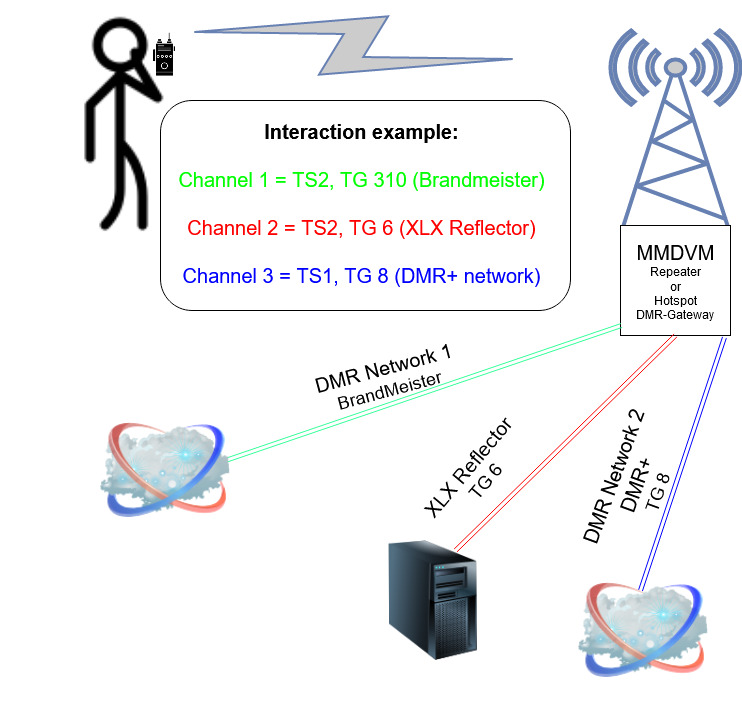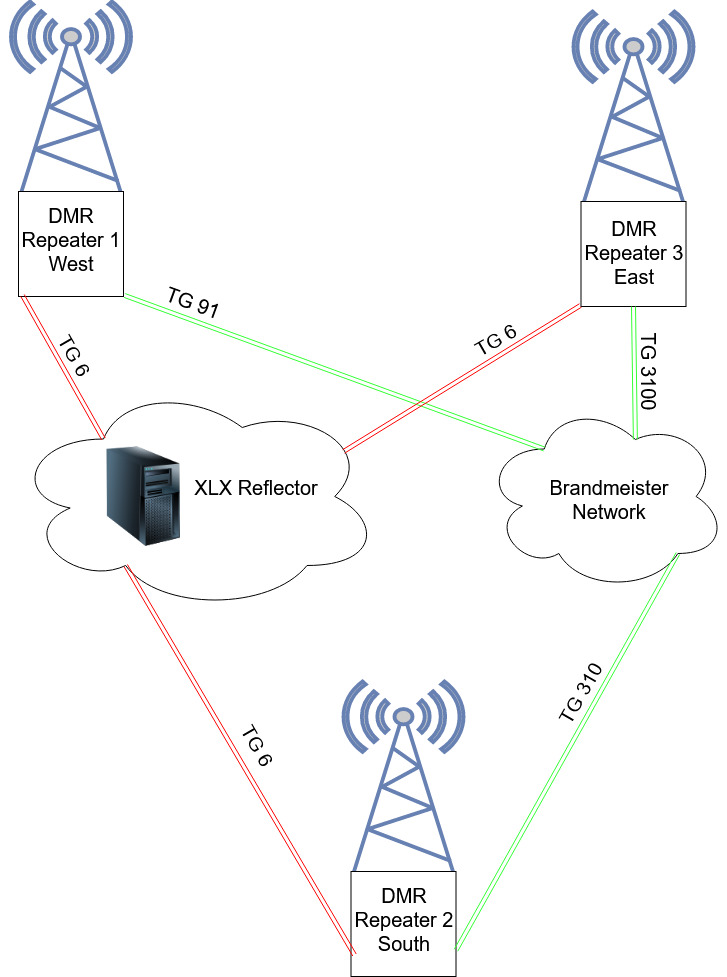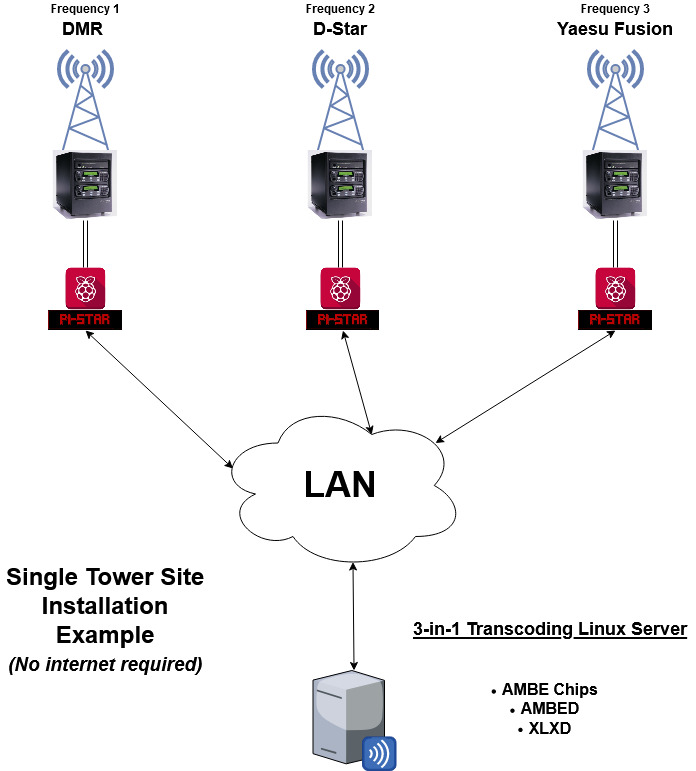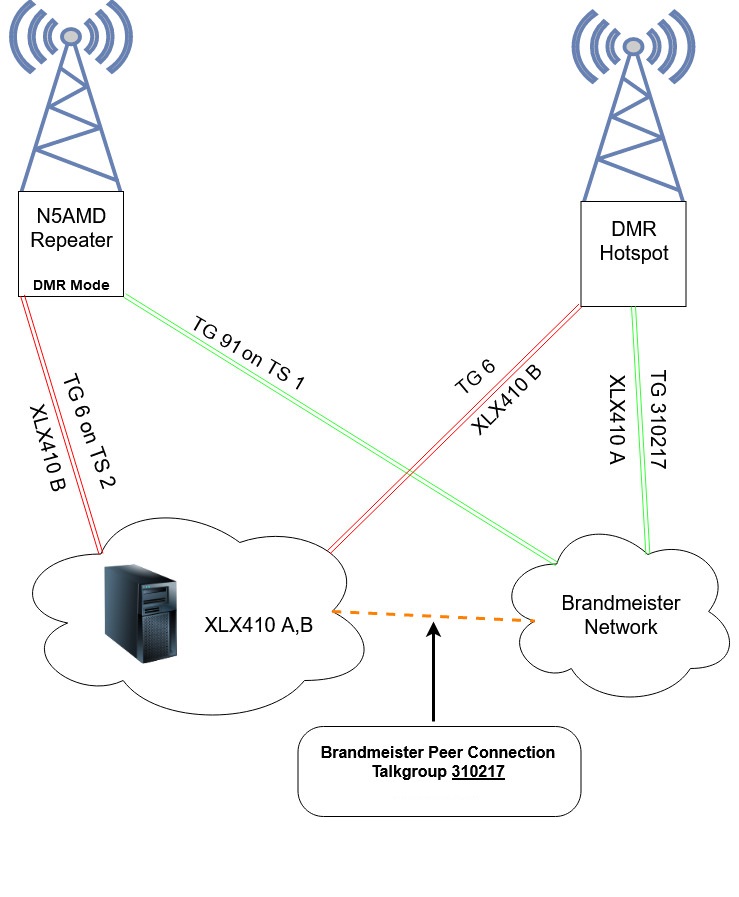updated: 09/03/2022
DMR Gateway is a part of the MMDVM_Host suite created by Johnathan Naylor (G4KLX) to add features and functionalities to the DMR side of the MMDVM. If you have never configured a commercial DMR Repeater before, its important to know for the most part, DMR repeaters are “Dumb” devices in the grand scheme of a network. At a high level, there is not much to configure; Frequency, Color code, Network master IP and config (if there is one) and maybe a couple personalized settings. A DMR Master device is where the logic and smarts are housed. The master is responsible for handling network call/sms routing, access control, and other features specific to a brand or network. Motorola IPSC and Brandmeister both approach IP networking features on DMR differently for example. When it comes to configuring an MMDVM DMR repeater/hotspot, it’s not much different from a commercial repeater. You configure basic settings like, frequency, color code, and which Master server to connect to and that’s it. If you need any special settings changed for your MMDVM DMR repeater like the callsign, its location, or static talkgroup settings, you do so on Brandmeister because its the master. (assuming your using Brandmeister)
This is where DMR Gateway comes into play. It gives the repeater/hotspot owner a little more control and the ability to connect up to 6 different DMR networks at the same time by use of “Rewrite rules”. This means instead of just connecting to Brandmeister, you can simultaneously connect directly to an XLX reflector, DMR+, a C-Bridge, TGIF or any other network all simultaneously. All you as a user have to do is change the channel on your radio and talk. As a programming example, Channel 1 can be one of your favorite Talkgroups on Brandmeister while channel 2 is your favorite XLX reflector.
Use Cases for DMR Gateway:
- Connect your repeater/hotspot to multiple DMR networks for personal use:

In this example, with Pi-Star and your radio’s codeplug configured already, you can use DMRGateway to listen to Brandmeister, an XLX reflector, and TGIF, and use each network by simply changing channels on your DMR radio. This helps make it easy to never miss anything on your favorite TG or network.
2. Cluster DMR repeaters together (over the internet or local WiFi / VPN coverage)

In this example, you can configure TG 6 to link directly to an XLX reflector module along with any other DMR repeater. So when TG 6 has traffic all repeaters connected will also have the same traffic. This can also be used as a backup connection to your personal XLX reflector IF you use Brandmeister as your main connection for DMR. Meaning, if BM is peered to your XLX reflector and the peer drops, you can still connect inbound via DMR. If you have a bunch of local regional DMR repeaters, this is a great use to cluster them together with your own infrastructure.
3. Private network for you and friends/family

This example is not much different from the last example. The main difference is the XLX reflector is setup as a private reflector not advertised or accessible without manually editing inbound host files on their pi-star devices.
4. A Single tower site that transcodes all digital voice modes

Most admins will spin up a cloud server or use a spare computer hosted locally for installing and running XLX. I wanted to toss out a unique way to use DMR Gateway to solve for any local regions problem of “I dont like Digital because the modes cant talk to each other” dilemma. It’s a valid argument for those who are weary of the digital world. Fortunately there are ways to combat this argument. For a relatively low cost and ease of installation, all without requiring internet, expensive combiner equipment, at a single high profile site, all digital modes can talk together. With the Anytone 578 mobile, DMR can be on 220MHZ (just as an example), D-Star on UHF, and Fusion on VHF, with little attenuation between all 3 modes. 3x repeater systems using pi-star/MMDVM connected over a local network into a physical server running both XLX and AMBEd along with the Vocoder Chips. This would mean:
- DMR users simply are told to use TG6 TS2
- D-Star users simply use the “Use Reflector” feature in DR mode radios
- Fusion users simply key up
- All stations/DV modes can hear and talk to each other that are within range of the tower site.
This method does have its draw backs, you cant allow users to change the default room or reflector. IF there was internet attached to the system users wont be able to steer their respective repeater away to another reflector/room/repeater without disconnecting the modes from talking to each other. Meaning, if a Fusion user wanted to switch and listen to Americas-Link, fusion would no longer be a part of this system until it gets linked back.
These are just a few examples of how you can incorporate the DMR Gateway feature into your daily digital voice routine. It’s another valuable tool for the digital voice world. DMR was created with the intent of linking repeaters together via any means possible. The ham radio home brew scene is taking off and taking full advantage of these features and abilities.
How N5AMD uses DMR Gateway
I use DMR Gateway to connect my repeater and hotspots together as though they all have their own private/secondary network sitting along side my Brandmeister connection. I do this by connecting everything to XLX410B on my DMR gateway configuration in Pi-Star, leaving Brandmeister connected simultaneously. I program TG6 into a channel for all my devices and have a constant connection with the flip of a channel. This gives me full control of having my own “network” without relying on either Brandmeister’s peer to my XLX Server or the uptime of their network.
